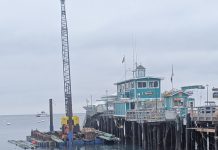From our “Maritime Mysteries” department comes this week’s column on an age-old, head-scratching riddle that has dogged historians for decades. I know that just this morning you, too, were wondering, “Where in the world was Spanish explorer Juan Rodriguez Cabrillo buried?”
From our “Maritime Mysteries” department comes this week’s column on an age-old, head-scratching riddle that has dogged historians for decades. I know that just this morning you, too, were wondering, “Where in the world was Spanish explorer Juan Rodriguez Cabrillo buried?”
For those of you unfamiliar with him, Cabrillo is probably best described as the Christopher Columbus of California, having maneuvered himself into the history books as supposedly the first European to explore the west coast of North America. I say “supposedly” because there are many tales in Native American lore regarding the visits of “bearded white men” to California before Cabrillo’s voyage. Even Cabrillo encountered such tales on his voyage to California. But this is all stuff for a future column.
Much of Cabrillo’s life, to say nothing of his death, is shrouded in mystery. No one is sure where or when he was born or who his parents were; two factors that lead historians to believe he was not born to any semblance of nobility or wealth.
In fact, for many years even his nationality was in doubt. Many historians originally believed he was Portuguese and not Spanish and it’s not uncommon to still find references to the Portuguese version of his name, “Joãn Rodrigues Cabrilho,” in old history books. This assertion, however, has been basically debunked and explained as an error attributed to a single historian or perhaps even to a printing error.
It has commonly been believed over the years that San Miguel Island off the Ventura County coast is where the indefatigable explorer met his doom and was forever interred. But a growing number of historians believe that he actually died at and is buried on—you guessed it—Catalina Island.
Most of the confusion surrounding his eternal whereabouts stems from the fact that the official log of his voyage to California in 1542 was lost.
To add insult to ignorance, early explorers had the nasty habit of applying more than one name to places they had visited and there is some confusion as to which islands they are referring to in their traipses around California’s Channel Islands. Most of what we know about Cabrillo’s voyage comes from a document called the Archivo General de los Indios, a deliciously monstrous volume of forgotten lore consisting of 70,000 pages of ship’s logs, legal documents and assorted statements by Spanish seafarers and land-owners in the New World.
According to the Archivo, the Native Americans of what is now Catalina Island referred to their home as “Limu,” often transliterated as “Pimu.” The crew of Cabrillo’s fleet referred to Limu variously as “La Isla Capitana,” “Isla de Juan Rodriguez” or by the official name that Cabrillo conferred upon the island—“San Salvador.” Confused yet?
Things got bad for Juan Cabrillo on Christmas Eve 1542 when a shore party ran into trouble with the locals while going ashore at “Isla Capitana.”(Although relations with those early Catalina Islanders had started out well, predictably perhaps, they eventually soured and Cabrillo’s confidant and fellow seaman Francisco de Vargas at one point recalled “all the time that the Armada was on the Isla Capitana the Indians there never stopped fighting us.”)
Remember, according to the Archivo, whenever either Vargas or fellow ship’s officer Lazaro Cardenas referred to “Isla Capitana” they were talking about Catalina, an island Cardenas described as “the most important island discovered on the expedition and the headquarters for all the fleet.”
Heedless of his own safety, Captain Cabrillo led a rescue party to shore, but as Cabrillo was de-boating on the island’s rocky shore, he “splintered a shinbone” and possibly broke his arm. Although everyone made it back to the ship in one piece, Cabrillo was doomed by the gangrene that developed in his leg.
On Jan. 3, 1543, Cabrillo died and, according to the Archivo, was buried on the island. “Because he died there,” wrote Cardenas, “the island retained the name ‘Capitana’, although some referred to it as ‘La Isla de Juan Rodriguez’.”
Sounds pretty straight forward to me, Catalina burial-wise. So where did anyone get it in their noggin that Cabrillo was buried on San Miguel Island, including a civic organization which put a monument there to the man in 1937 (with the Portuguese spelling of his name)?
Most of this belief stems from a mysterious stone tablet that was found on San Miguel in the spring of 1901. A lone archaeologist was wandering that windswept isle one day when he kicked what he thought was a stone metate and noticed some scribbling on one side. Those scribblings, or etchings, sort-of appear to form the letters “JRC,” leading some to believe that this piece of rock may have been Cabrillo’s headstone.
Many historians and archaeologists, however, have called into question the authenticity of the tablet, especially since the phrase “Follow Me on Twitter!” appears beneath the letters.
Various expeditions to find Cabrillo’s grave have been launched over the past 150 years to not only San Miguel and Catalina islands, but—just to be on the safe side—to Santa Cruz Island and Santa Rosa Island as well. But, alas, not a shred of evidence one way or the other has ever been found.










